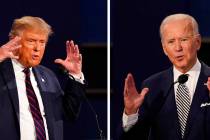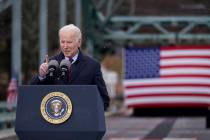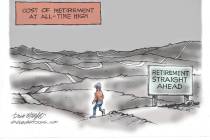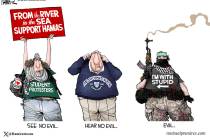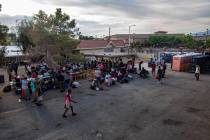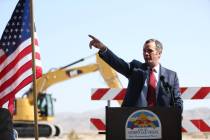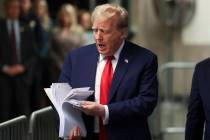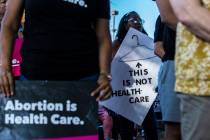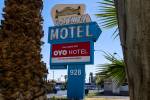Put new City Hall on ice
Let's start here: Downtown redevelopment is a good thing. Cities benefit from a thriving core -- a commercial, cultural and residential hub that draws residents and visitors who are enlivened by the energy of a genuine urban experience.
Without dissing the suburbs -- I enjoy a pleasant enough suburban existence here -- we know what this true urban experience looks like. It's the melange of people and places in Manhattan, Chicago, San Francisco. It's a setting that draws creative people -- artists, writers, musicians, architects, actors and intense devotees of the arts. It tends to encourage civic engagement, tolerance and diversity, achieving a sense of community-mindedness that's difficult to cultivate in the sprawl of a city's outer reaches.
That, of course, is the touchy-feely appeal of downtown redevelopment. The other piece is less idealistic: It's about making money.
Las Vegas downtown redevelopment has focused mostly on the latter part of the equation. Since the initiative started in the late 1980s, the primary goal has been to support the Fremont Street casinos so they don't get killed off by the Strip.
When Mayor Oscar Goodman donned the downtown redevelopment mantle, he expanded the vision a bit, dutifully promoting the arts district and the Fremont East entertainment district as essential components of a vibrant downtown. But what he has really wanted all along is a sports venue to host a big-league team. That's more about money than urban idealism.
Although he hasn't yet landed a basketball arena or baseball stadium, Goodman has seen considerable downtown progress during his tenure. His vision, however, is much broader than the handful of success stories thus far. Among other things, he wants a new hotel-casino, a museum and a new City Hall.
The economic crisis has the potential to derail his plans. The city is facing the prospect of a substantial budget deficit that could result in reduced public services such as police and fire protection. Undeterred, Goodman has cooked up a scheme to borrow $80 million from the city's sewer fund to help make it all happen.
Some folks don't think this is a sound idea.
The most high-powered critic is the Culinary union. It has put its shoulder behind a campaign to stop the City Hall project, which has a price tag of at least $150 million. The union argues that the city is offering too many tax breaks and other financial incentives to the developer, Forest City Enterprises, and not demanding sufficient community benefits, such as wage and benefit standards, local-hiring guarantees and affordable housing, in return. Besides, the union contends, now is the wrong time to spend more than $150 million on a new city edifice.
Goodman counters that now is a perfect time to put thousands of people to work building a new City Hall, as well as other downtown projects. Just as President Obama and Congress have created a huge economic stimulus plan, the city could contribute to the cause. In an interview this week with The New York Times, Goodman noted that the Empire State Building, Chrysler Building and Rockefeller Center were built during the Great Depression.
Here's my take: All the downtown plans sound pretty good -- except the new City Hall. Go ahead and build out the Union Park master plan, but put the City Hall on ice.
The City Hall is the Achilles' heel of Goodman's vision. It's a public relations nightmare far scarier than the so-called mob museum. Although Goodman was ridiculed for suggesting that the mob museum receive economic stimulus funding, it's still a worthwhile project, capable of attracting visitors to downtown.
By contrast, the City Hall won't attract anybody except municipal employees who already commute downtown each day and a handful of citizens forced to conduct some kind of business there once in a while. It's also not needed anytime soon, considering that the city recently expanded its existing City Hall and that the city has all but stopped growing.
There's also a big perception problem: A lot of people are looking at the new City Hall as little more than a monument to Goodman, a "Taj Mahal," as Culinary Local 226 Secretary-Treasurer D. Taylor calls it, to commemorate his legacy.
The mayor could eliminate much of the criticism of his downtown plans if the City Hall were pulled off the table. It probably will be needed someday, but for now, let's focus on other priorities.
The top downtown priority, I think, should be the long-planned Smith Center for the Performing Arts. If the city has money to throw around, perhaps it could chip in the remaining amount needed to get the center built. The same construction crews that would be employed to build the City Hall could be put to work on the Smith center, achieving the goal of stimulating the economy and spurring further downtown activity. And the end product will be of greater value to the populace.
The new City Hall seems to be a huge blind spot for the mayor. If he insists on it, it could tarnish what is shaping up as an enviable era of downtown revival.
Geoff Schumacher (gschumacher@reviewjournal.com) is director of community publications for the Review-Journal. His column appears Friday. His blog can be found at www.lvrj.com/blogs/schumacher.








